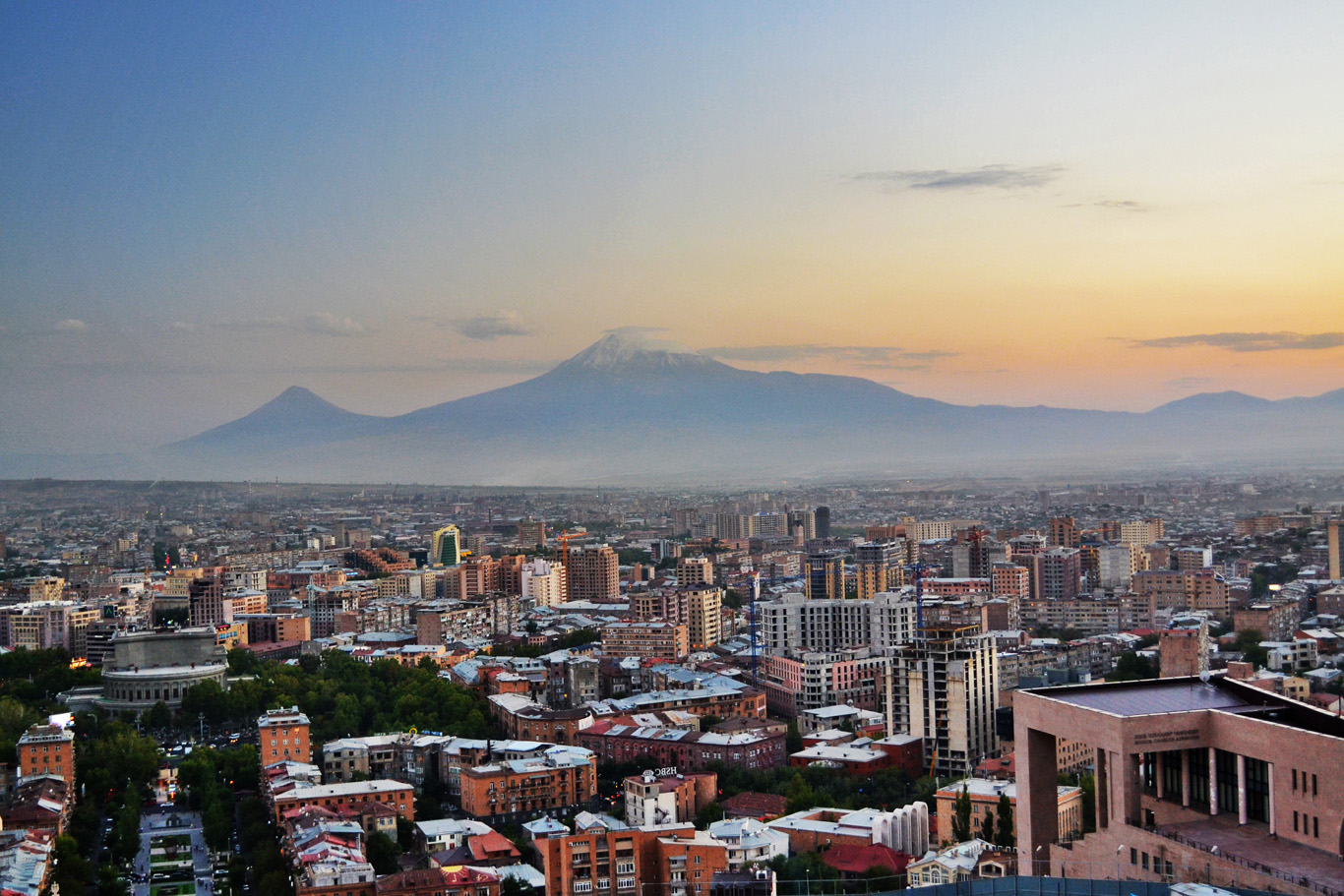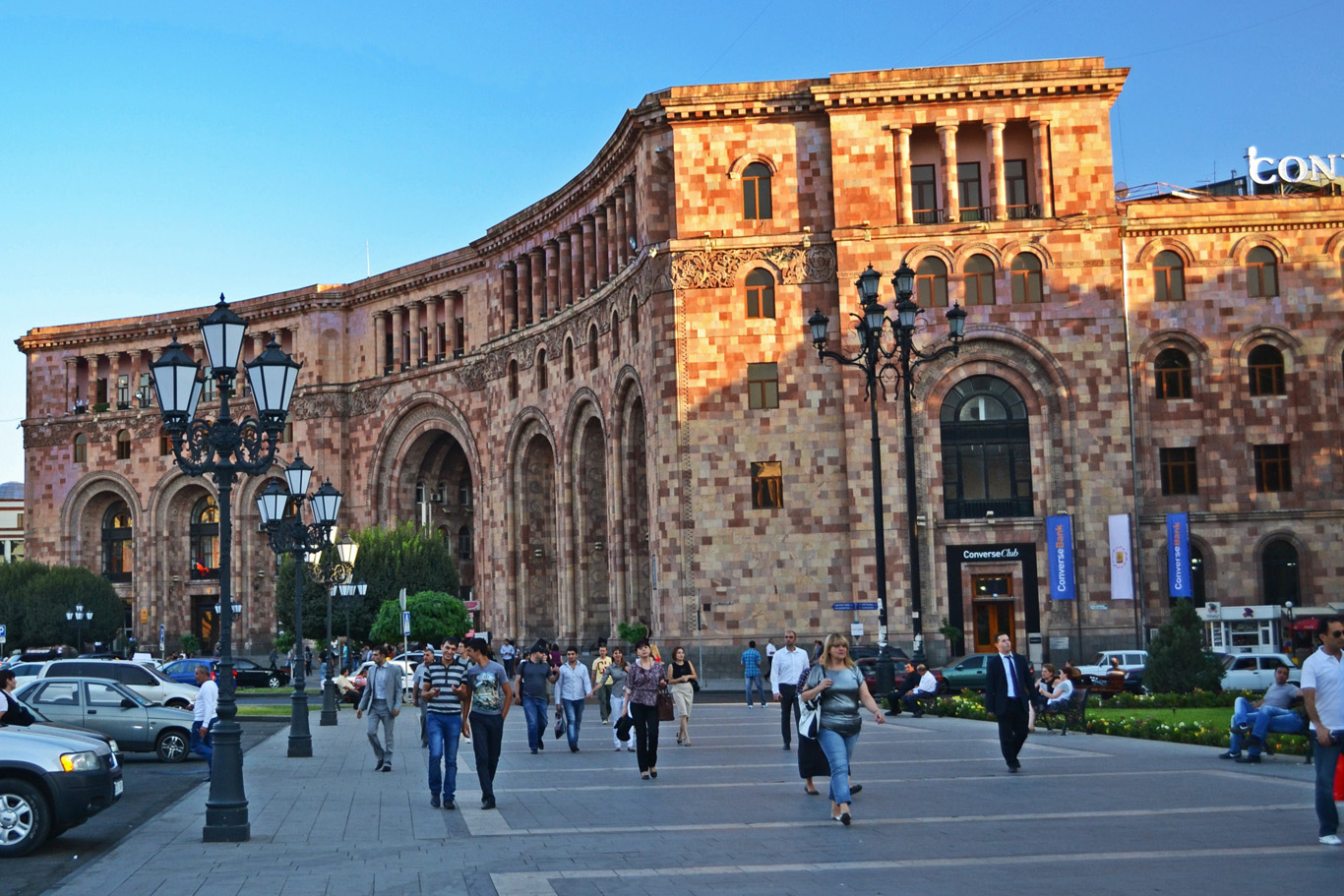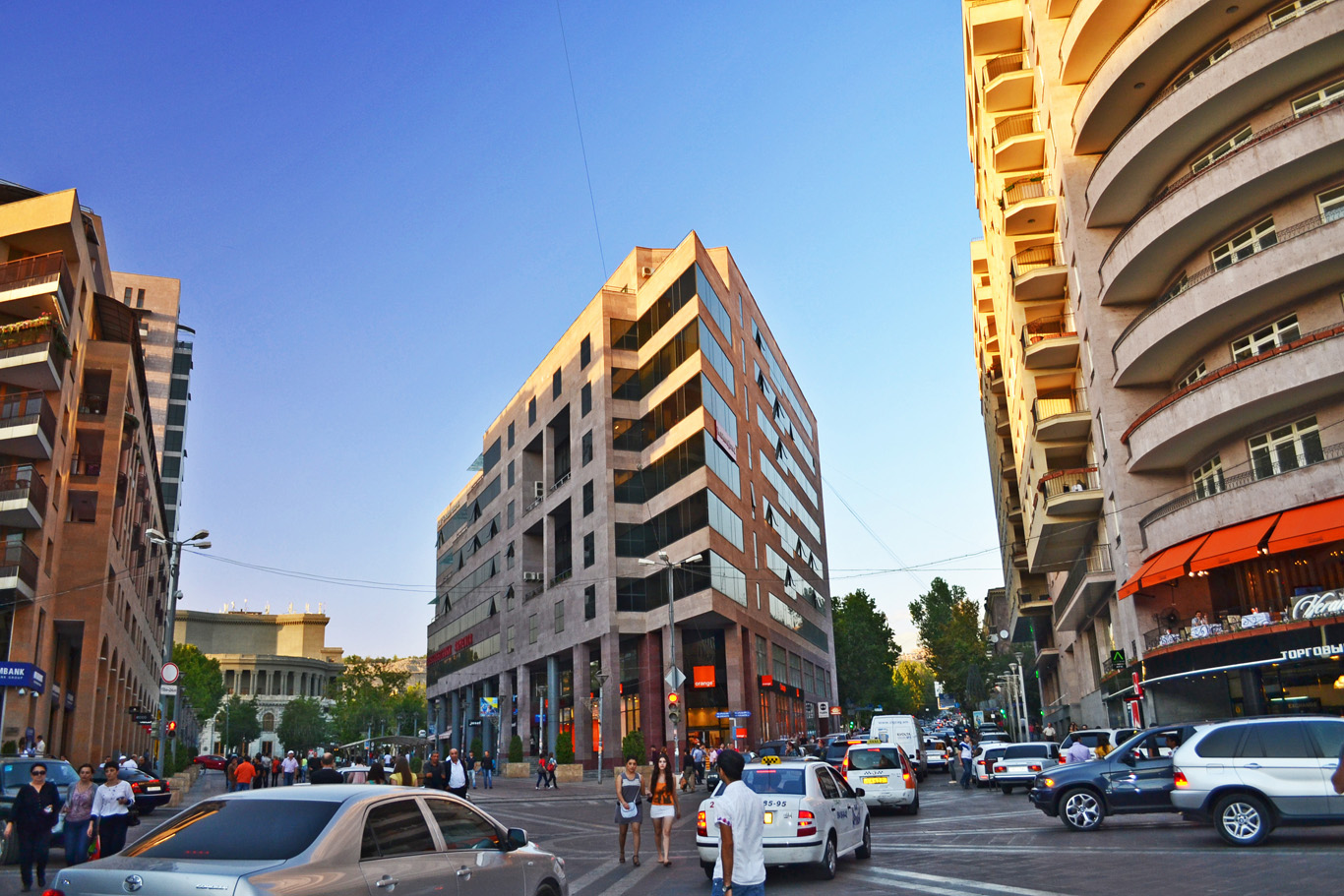Yerevan, the capital of Armenia is called "The pink city" because of the color of the stone used for building. Indeed, while driving through Armenian countryside you can easily spot that the houses along the way blend into the pinkish hills. Yerevan is a great example of the architecture from the Soviet Times. The buildings are concrete, heavy, and massive, streets are wide and the center city square is very spacious. After the world wars, the city of Yerevan was supposed to become 'a perfect city', designed by the architect Alexander Tamanyan. Yerevan is completely different than the neighboring capital of Georgia - Tbilisi that has medieval charm and wooden architecture with distinctive balconies leaning out over the cliffs. It' good to visit the two cities one after another, this way you will be able to experience the clash of two different eras even more.
Republic square in Yerevan
Yerevan with Mount Ararat in the background
Yerevan
How to get to Yerevan
Yerevan is connected very well with all major European and Middle East cities by air. Another great option is to get here from Tbilisi in Georgia. There are daily overnight trains or very frequently operating mini buses (marshrutkas). The journey with marshrutka will take around 5 hours and cost around 7500 AMD (14 EUR/18 USD). Along the way, you will admire spectacular views of gorges, canyons and also the sad reminders of the past, falling apart Soviet factories and abandoned, crumbling buildings. Don't try to get to Armenia from Azerbaijan because the conflict between the two countries is still on and most probably you won't even be able to cross the border. Turkish border is also closed due to Armenian-Turkish tensions.
Republic square
National Art and History Museum in Yerevan
At the cascades
History of Yerevan
History of Yerevan began in the eighth century BC when the fortress of Erebuni was founded in 782 BC by king Argishti I. Since then, the Armenian capital has been one of the oldest continuously inhabited cities in the world. Yerevan, due to its location was always the center of battles, invasions and clashes by its neighboring empires - Arab, Persian, Ottoman and Russian. The city was leveled to the ground several times not only by invaders but also by natural disasters like earthquakes. Not much of ancient Yerevan has been preserved to this day. The ruins of the Erebuni fortress that give testimony of the greatness of Armenian culture and history are one of the few examples. After the first world war, Yerevan was a small town with only around thirty thousand inhabitants. The survivors of Armenian Genocide started to come back to their fatherland and settle there. In the twentieth century, Armenia became a part of the Soviet Union and Yerevan expanded rapidly during those times. The population grew to around one million within a century.
After the collapse of the Soviet Union, Armenia didn't handle the transition from communism to free market economy very well and many factories, state farms and other forms of industry stopped operating causing many problems in the country's economy. Nowadays, Yerevan is being reconstructed and it reminds a big construction site. There are many new investments in the area although the level of poverty and the shadows of past times of the Communism Era are still clearly noticeable. However, don't let this discourage you from visiting Yerevan in Armenia as it has a lot to offer culturally and historically (more than you would expect from such a small country), not to mention beautiful scenery and nature.
Northern Avenue in Yerevan
Northern Avenue in Yerevan
Modern Yerevan
What to visit in Yerevan
The Cascades and Museums
Yerevan has many interesting museums with exhibitions ranging from ancient times to Soviet era and modern times. National history museum has exhibitions from the period of Erebuni fortress (782 BC). Another exhibition worth visiting is the history of Armenian alphabet. It includes the collections of ancient, ideally preserved original books written in Armenian. You will be amazed that the colors are still so bright as if the illustrations were painted yesterday. There are also art museums (National Art Museum and Saryan and Cafesjian Museums). The main part of the Cafesjian Museum are the cascades - open-air huge steps leading to the top of the hill with an unforgettable view of Mount Ararat and the city of Yerevan, especially at night. The cascades are decorated with sculptures, fountains and patches of grass. It takes some time to reach the top but there are also free elevators available for public.
Opera house
Opera house is an another example of the 'heavy' Yerevan architecture, however the two-sided building is charming and beautiful. It was designed by the Soviet era architect - Alexander Tamanian in 1933. A unique Armenian opera "Anoush" by Armen Tigranian has been performed in the Theater since 1935. It can also boast many operas and ballets by well known composers. It is connected with the Republic Square by a lovely park with many cafes, restaurants and little fountains where people come to enjoy the evening after the hot and dry summer days.
Restaurant in Yerevan
Amazing view of Yerevan and Mount Ararat from the cascades
Dancing fountains
Dancing fountains
Republic Square and The Dancing Fountains
The massive, circular square located in the center of Yerevan is one of the finest example of the Soviet era design. The buildings are 'heavy' but they have the pleasant orange-pink color which looks beautiful especially before the sunset. After dark, the crowds gather around the Dancing Fountains to watch them jump to the music. Also, sometimes laser lights are combined with the Dancing Fountains and the whole show is truly colorful and impressive.
Northern Avenue
Northern Avenue is a pedestrian avenue connecting the Opera with the Republic Square. It's rich in all kinds of shops and stores (including the high class ones) and also good restaurants. The post-modern architecture of the newly renovated buildings is similar to the architecture of the Republic Square with pinkish-orange stone constructions.
Cafes and restaurants
It's not difficult to find a nice and cozy restaurant in Yerevan. The food is naturally delicious and you will be nicely surprised when the check comes. Prices are really low. I paid for a nice meal and a drink 3200 AMD (around 6 EUR/7.70 USD)! Many restaurants are situated in underground cellars with beautifully decorated stone walls, it's cooler there and you might choose one while seeking shelter from the summer heat. The only drawback is that it seems that literally everybody smokes in Yerevan. If you can't stand the smell of cigarette smoke, it's better for you to go to one of the open-air restaurants in one of the parks.
The view of Mount Ararat
Yerevan offers probably the best view of Mount Ararat, the mountain where Noah's Ark is believed to have landed after the biblical flood. Mount Ararat should be watched from the Cascades in the center of Yerevan. Shortly after dark, on a clear day you will be able to admire not only the two snowy peaks of the mountain but also beautiful night lights of the Armenian Capital. It's an ideal place for landscape photography.
Opera house
Opera house
Armenian Language Museum
Armenian Genocide Memorial
Armenian Genocide, also known as Armenian Holocaust are the events that led to the mass extermination of Armenian minorities by the Ottoman Empire Government during the first world war. It has been estimated that around 1.5 million of people were murdered in a few phases. The first phase was to get rid of all the men and intellectuals by engaging them in heavy labor and forcing into the army where they were killed by their fellow Turkish soldiers. Then, in the next phases women, children and the elderly were deported to Syria (death marches to the desserts) where they died from diseases deprived of any help, medications and food supplies. Twenty countries accept the events as genocide, however Turkish government denies it, claiming that the atrocities were not deliberate or committed by the government. Because of this, relations between Turkey and Armenia are still tense. The site reminds of the concentration camp in Auschwitz, it's full of sorrow and painful memories, but it's a must-see if you wish to understand well the history of the country. More info on the official website of the memorial: http://www.genocide-museum.am/eng/index.php
Armenian Genocide Memorial
Armenian Genocide Memorial
Gospel of Echmiadzin, Ivory binding, 6th century
Naturally colored book in Armenian Language Exhibition
Natural dyes used for coloring
Cascades in Yerevan
Republic Square at night
Sunset
If you liked this article, you can also download it via the GPSmyCity app - you will be able to gain access to the guide, which will direct you to all the attractions described above, even if you're offline. Download it here.
Related Posts
Copying without permission is not allowed. If you wish to use any of the site's content (photos or text) or work with us, please contact us.
We welcome questions, advice, support or criticism. However, spam comments will be removed.































